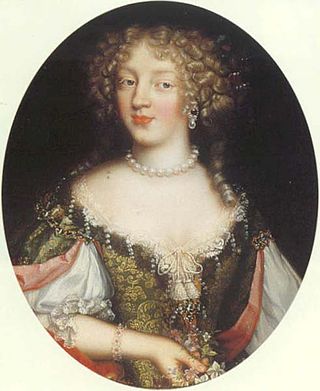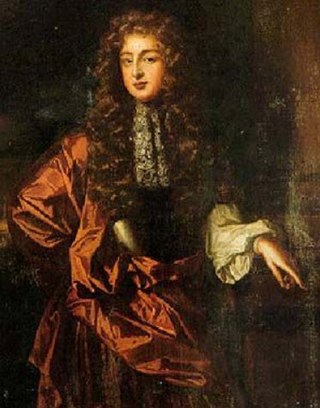Related Research Articles

Patrick Sarsfield, 1st Earl of Lucan was an Irish soldier and Jacobite. Killed at Landen in 1693 while serving in the French army, he is now best remembered as an Irish patriot and military hero.

The siege of Derry in 1689 was the first major event in the Williamite War in Ireland. The siege was preceded by an attempt against the town by Jacobite forces on 7 December 1688 that was foiled when 13 apprentices shut the gates. This was an act of rebellion against James II.

The Williamite War in Ireland took place from March 1689 to October 1691. Fought by Jacobite supporters of James II and his successor, William III, it resulted in a Williamite victory. It is generally viewed as a related conflict of the 1688 to 1697 Nine Years' War.

The Battle of Aughrim was the decisive battle of the Williamite War in Ireland. It was fought between the largely Irish Jacobite army loyal to James II and the forces of William III on 12 July 1691, near the village of Aughrim, County Galway.

Richard Talbot, 1st Earl of Tyrconnell, was an Irish politician, courtier and soldier.

Frances Talbot, Countess of Tyrconnell, also called La Belle Jennings, was a maid of honour to the Duchess of York and, like her sister Sarah, a famous beauty at the Restoration court. She married first George Hamilton and then Richard Talbot, Earl of Tyrconnell. She was vicereine in Dublin Castle while Tyrconnell was viceroy of Ireland for James II. She lived through difficult times after the death of her second husband, who was attainted as a Jacobite, but recovered some of his wealth and died a devout Catholic despite having been raised as a Protestant.

A Williamite was a follower of King William III of England who deposed King James II and VII in the Glorious Revolution. William, the Stadtholder of the Dutch Republic, replaced James with the support of English Whigs.

Claud Hamilton, 4th Earl of Abercorn PC (Ire) (1659–1691) was a Scottish and Irish peer who fought for the Jacobites in the Williamite War. He went with King James to Derry in 1689 and tried to negotiate the surrender of the town with Adam Murray. He raised a regiment of horse that he led in the defeats of Newtownbutler in 1689 and Aughrim in 1691. He was killed when the ship that should have brought him to France was intercepted by a Dutch privateer.

Limerick, a city in western Ireland, was besieged twice in the Williamite War in Ireland in 1689–1691. On the first occasion, in August to September 1690, its Jacobite defenders retreated to the city after their defeat at the Battle of the Boyne. The Williamites, under William III, tried to take Limerick by storm but were driven off and had to retire into their winter quarters.
The Break of Dromore took place on 14 March 1689 near Dromore, County Down in the early stages of the Williamite War in Ireland. It featured Catholic Jacobite troops under Richard Hamilton and Protestant Williamite militia led by Hugh Montgomery and Arthur Rawdon.
Events from the year 1689 in Ireland.

Henry Dillon, 8th Viscount Dillon was an Irish soldier and politician. In 1689 he sat in the Patriot Parliament. He fought for the Jacobites during the Williamite War, defending Galway against Ginkel and surrendering it in 1691 after a short siege. He obtained the reversal of his father's attainder in 1696 recovering his father's lands.
Alexander MacDonnell, 3rd Earl of AntrimPC (Ire) was a Catholic peer and military commander in Ireland. He fought together with his brother Randal on the losing side in the Irish Confederate Wars (1641–1653); and then, having succeeded his brother as the 3rd Earl of Antrim in 1683, fought in the Williamite War (1688–1691), on the losing side again. Twice he forfeited his lands and twice he regained them.

William Stewart, 1st Viscount Mountjoy (1653–1692), was an Anglo-Irish soldier.
Richard Hamilton PC (Ire) was an officer in the French and the Irish army. In France he fought in the Franco-Dutch War (1672–1678) under Turenne and in the War of the Reunions (1683–1684) at the Siege of Luxembourg.
Sir Robert Talbot, 2nd Baronet of Carton was an Irish landowner, soldier, and politician. He sat for County Wicklow in the Irish parliament 1634–1635.
Mark Talbot was an Irish soldier and politician. He was born in Ireland and served in the French army during a time when Irish Catholics were prohibited from serving in the Irish and English armies. His father rose in prominence during the reign of the Catholic James II of Ireland, who purged Protestants from the military and replaced them with Catholics.

William Dorrington was an English army officer. Contemporary sources often spell his surname as "Dorington", or "Dodington".
Dominic Sheldon, often written as Dominick Sheldon, was an English soldier. A leading Jacobite he served in James II's Irish Army during the Williamite War between 1689 and 1691. He was a noted cavalry commander, present at the Battle of the Boyne and Battle of Aughrim. Later after going into exile, he rose to the rank of lieutenant general in the French Army. He was also remained a prominent courtier at the Jacobite court in exile at Saint Germain.
William Talbot was an Irish Jacobite politician.
References
- ↑ Burke & Fox-Davies 1912, p. 678, left column, line 68. "Walter Talbot, of Ballynamony, High Sheriff co. Wexford 1649."
- ↑ Burke & Fox-Davies1912, p. 678, left column, line=69. "He [Walter Talbot] m. [married] Elinor, dau. [daughter] of William Esmonde ..."
- ↑ Burke & Fox-Davies 1912, p. 678,, right column, line 25. "He m. [married] Margaret, dau. [daughter] of Richard Masterson ..."
- ↑ D'Alton 1855, p. 51. "... another William Talbot was one of the members for the Borough of Wexford. This last was of the Ballynamoney (now Castle Talbot) line, son of Walter Talbot who had been High Sheriff of the County of Wexford in 1649. He was killed at Derry ..."
- ↑ Simms 1969, p. 82. "Tyrconnell's nephew, Sir William Talbot, was sent to implore the Lords ..."
- ↑ Fryde et al. 1986, p. 170, line 10. "1687, 8 Jan. / 12 Feb. / Richard, 1st e. [earl] of Tyrconnell L.D. [Lord Deputy]"
- ↑ Lenihan 2014, p. 118.
- ↑ Lenihan 2014, p. 179.
- ↑ Childs 2007, p. 109. "... who had personally agreed to ransom Lieutenant Colonel 'Wicked Will' Talbot for £500 ..."
- ↑ Macpherson 1775, p. 202, footnote: "... brigadier Talbot, formerly called Wicked Will, and nephew to Tyrconnell, taken, and dead and buried this day [26 June 1689] of his wounds."
- ↑ Witherow 1879, p. 129. "... Lieutenant-Colonel Talbot — the brother of the Lord Deputy Tyrconnel."
- ↑ Doherty 2008, p. 106. "... Lieutenant Colonel William Talbot, a son of the late Sir Henry Talbot and a cousin of Tyrconnel ..."
Sources
- Burke, Sir Bernard; Fox-Davies, Arthur Charles (1912). A Genealogical and Heraldic History of the Landed Gentry of Ireland (New ed.). London: Harrison & Sons. OCLC 1045621157.
- Childs, John (2007). The Williamite Wars in Ireland 1688–1691. London: Hambledon Continuum Press. ISBN 978-1-85285-573-4. – (Preview)
- D'Alton, John (1855). Illustrations, historical and genealogical, of King James's Irish army list, 1689. Dublin: Published by the author. OCLC 838655763.
- Doherty, Richard (2008). The Siege of Derry 1689 – The Military History. Stroud, Gloucestershire, England: Spellmount. ISBN 978-1-86227-454-9. – (Snippet view)
- Fryde, Edmund Boleslaw; Greenway, D. E.; Porter, S.; Roy, I., eds. (1986). Handbook of British Chronology . Royal Historical Society Guides and Handbooks, No. 2 (3rd ed.). London: Offices of the Royal Historical Society. ISBN 0-86193-106-8.
- Lenihan, Pádraig (2014). The last Cavalier: Richard Talbot (1631–91). Dublin: University College of Dublin Press. ISBN 978-1-906359-83-6. – Does not seem to be available online
- Macpherson, James (1775). Original Papers: Containing the Secret History of Great Britain, from the Restoration to the Accession of the House of Hanover. To which are Prefixed Extracts from the Life of James II. Written by Himself. London: W Strahan and T Cadell. OCLC 1050258341.
- Simms, John Gerald (1969). Jacobite Ireland, 1685–91. London: Routledge & Kegan Paul. ISBN 978-0-7100-6446-2.
- Witherow, Thomas (1879). Derry and Enniskillen in the Year 1689. London & Belfast: William Mallan & Son. OCLC 82779901.